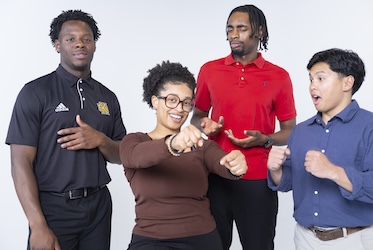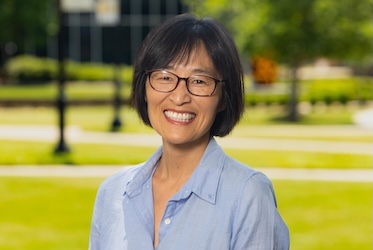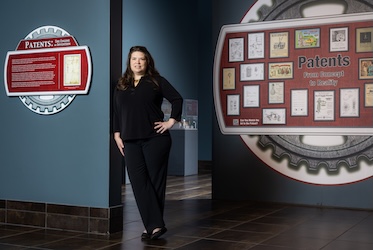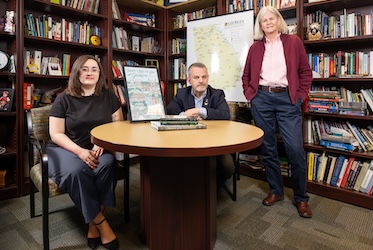
Reading Early
KENNESAW, Ga. | Aug 7, 2017
KSU alum promotes literacy for the very young

When the 2- to 4-year-olds in Naomi Hill Bradley’s nonprofit tutoring academy finish reciting their phonics drill or remain attentive as they read sentences with repetitious, rhyming words, she gently directs them to “kiss your brain.” They enthusiastically press their tiny hands to their lips and tap their heads.
Helping children experience the success of learning to read at an early age has coalesced into a life work and lifestyle for Bradley, who earned her bachelor’s degree in elementary and early childhood education at Kennesaw State’s Bagwell College of Education in 2009. She operates the Love Bradley Academy year-round in a converted house in Decatur, where she also homeschools three of her four children. She also has expanded into publishing, with four books promoting literacy to her credit.
Bradley’s first book, “Reading at One: A Guide to Early Literacy Exposure for Toddlers and Children,” is a memoir and instruction guide that grew from rigorous academic study, experiences teaching kindergarten, first-, third- and fifth-graders, and most critically, from the birth and development of her first child, a daughter named Love, who at 4 is reading at third-grade level.
“In the early years of teaching, I learned important lessons like how to talk to children and get them to retain information, how to organize material and manage a classroom,” said Bradley, who also holds a master’s degree in middle grades education from Valdosta State University and has taught 10 years in public and charter schools in Kennesaw, Decatur and College Park. “But it was my experience as a mother to Love that showed me that with deliberate instruction and communication, children as early as 1 can begin learning to read.”
In her book, Bradley said she took full advantage of her six weeks of maternity leave to really learn her baby – observing, interacting and listening. She found that Love reacted very strongly to light and would stare and smile at lighted mirrors and screens like the television, no matter how much she was distracted from them.
“Love was telling me that she was a visual learner,” Bradley writes. “Although people have multiple intelligences and learning styles … babies often demonstrate their preferences very early on. You have to listen to your baby.”
Before Love was 1, Hill decided to make her some flashcards because the commercial ones were too confusing and inconsistent in terms of letter sounds, she said, like using the word and picture of an eye on a card with the letter “E.” She had her students at Hayes Elementary School in Kennesaw color the cards, which she laminated.
“I would read the cards to Love every day after picking her up from the caretaker (Bradley’s mother, Faith Hill) and she loved it,” Bradley recalled. “My mom said Love had already asked to do the cards several times during the day. It came to the point when, as soon as I walked through the door, she would hand me the cards [to read to her].”

Her second book, “Big Book of Beginner Reading Stories,” is a companion to the first, presenting read-aloud stories for new readers and incorporating phonics, sight words, rhymes and word families. Bradley said she developed the book to create stories with characters to which her children and other African-American children could relate.

“There were so few good readers with black characters, and I felt strongly that black children need to see themselves as much as possible in their reading materials,” said Bradley, who used a similar approach to develop her subsequent books, “Aaron Knows About Africa” and “Good Night Princess.” “It lends itself to building positive self-esteem.”
Bradley also notes the importance of music in stimulating very young subconscious minds. She regularly employs music in her teaching. In “Reading at One,” she urges parents to sing to their children, even if they don’t have good voices. Developing children requires “selfless embarrassment,” she noted.
“In order to have a child that speaks and reads at a young age, you must flood their subconscious minds with whatever you desire them to know,” she said. “Looking your baby square in the eye and singing to them is like taking your baby to Harvard.”
— Sabbaye McGriff
Photos by David Caselli
Related Stories

Kennesaw State to revive bathtub race tradition with new video game

Kennesaw State professor earns Mid-Career Award from American Educational Research Association

Master's degree led Kennesaw State alumna to career as museum collection manager

Kennesaw State alumni, professor offer guide to Georgia's historic sites in new book
A leader in innovative teaching and learning, Kennesaw State University offers undergraduate, graduate, and doctoral degrees to its more than 47,000 students. Kennesaw State is a member of the University System of Georgia with 11 academic colleges. The university’s vibrant campus culture, diverse population, strong global ties, and entrepreneurial spirit draw students from throughout the country and the world. Kennesaw State is a Carnegie-designated doctoral research institution (R2), placing it among an elite group of only 8 percent of U.S. colleges and universities with an R1 or R2 status. For more information, visit kennesaw.edu.















